The 435th weekly post of the CIES football observatory ranked the top-100 midfield distributors in the world from a field of those who’ve played at least 450 league minutes in the current campaign.
As explained in the post, this ranking was based on Wyscout data relating to successful passes per match, percentage of successful passes, ratio of passes compared to teammates and a weight was given to the level of matches played.
The type of player highlighted in this post was the type who’s regularly involved in their team’s possession play, constantly receiving and relaying the ball off to other teammates as they seek opportunities for progression. This player’s ability to find space and reliability on the ball makes them a crucial component of the build-up and progression phases.
Three of the top-100 came from France’s Ligue 1 — Angel Gomes of Lille, Pedro Chirivella of Nantes and Jordan Ferri of Montpellier; this tactical analysis and scout report will go into detail on exactly why these three have had a light shone on them as France’s top-three ball distributors. Our analysis will go into detail on these players’ roles within their respective teams’ tactics and pinpoint key qualities that help them perform that role to such a high level.
Angel Gomes, 23 years old, Lille
We’ll kick off our analysis by looking at Lille’s Angel Gomes (168cm/5’6”, 56kg/123lbs). The Manchester United academy product has enjoyed a few years of growth since departing Old Trafford on a European adventure, initially being sent out on loan to Boavista after making his move to Decathlon Arena – Stade Pierre Mauroy back in 2020 before enjoying his first full season in Ligue 1 in 2021/22 and establishing himself as a starter last season.
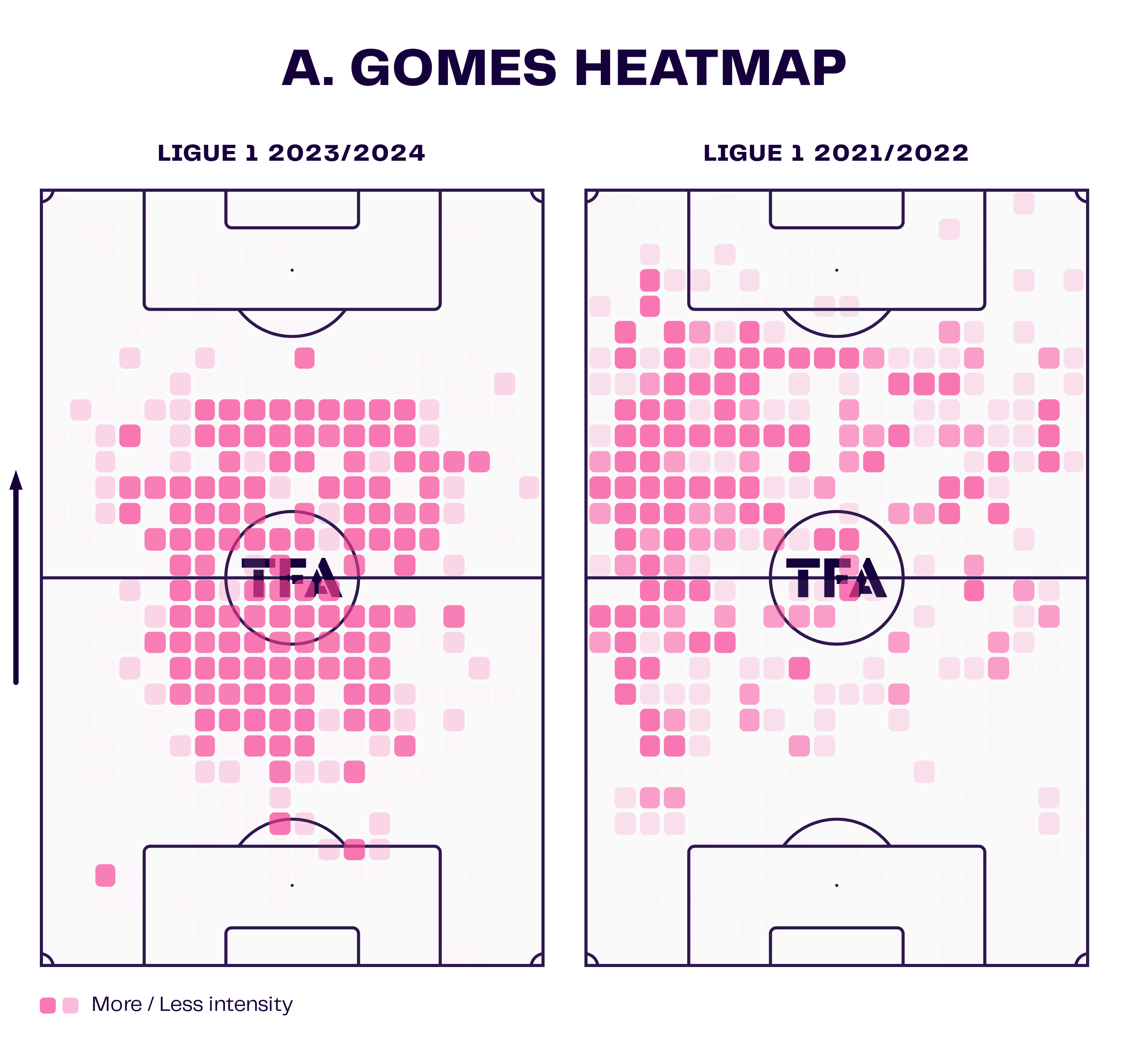
The major change in Gomes’ game throughout his time in France has been the way in which he’s been occupying deeper zones of the pitch more frequently. The above heatmaps indicate how he’s moved from primarily occupying the left half-space area in and around the final third to primarily occupying the central area just in front of the centre-backs.
It’s this change that’s led him to honing the skills necessary to become one of world football’s top ball distributors in 2023.
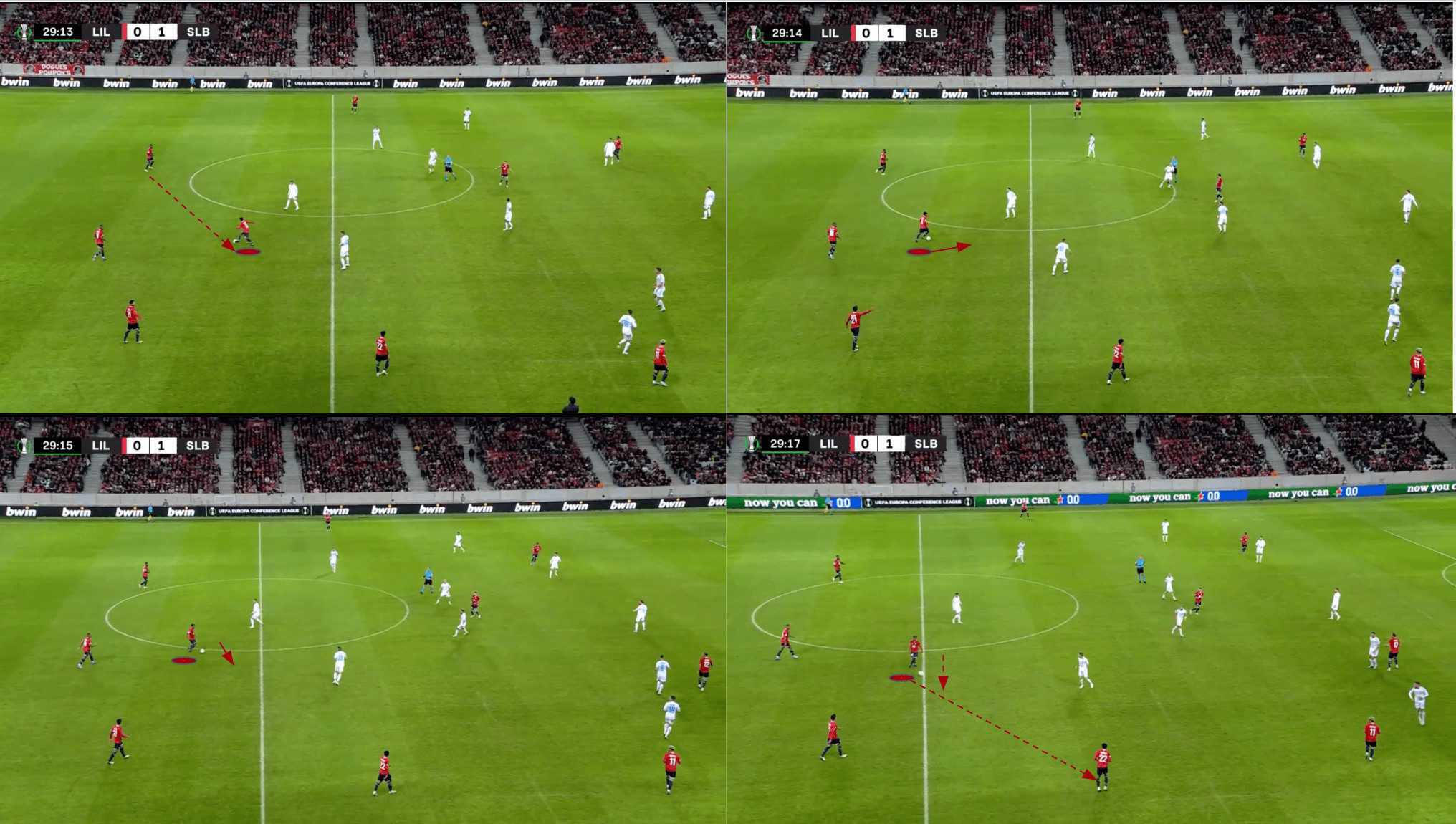
The first skills we’ll touch on regarding the 23-year-old midfielder are displayed in figure 2 — his ability to receive on the half-turn and agility to continue turning while searching for the best progressive passing option from here almost as if he’s perched on a rotating platform.
Here, we see Gomes receiving just in front of the centre-backs while facing them. However, the nimble midfielder is able to quickly turn and face the opposition’s end of the pitch before continuing to quickly turn at sharp angles while surveying the pitch ahead. In the end, he opts for a pass out to the right wing.
Gomes plays with a sense of urgency while still endeavouring to find the best possible passing option. His agility makes him very press-resistant and this, combined with the fact he doesn’t tend to hang on the ball and looks to keep it moving quickly, means the opposition struggle to close him down when he receives in space like this deep. Throughout his time at Lille, he’s developed in a very positive way to achieve this quality in his role.
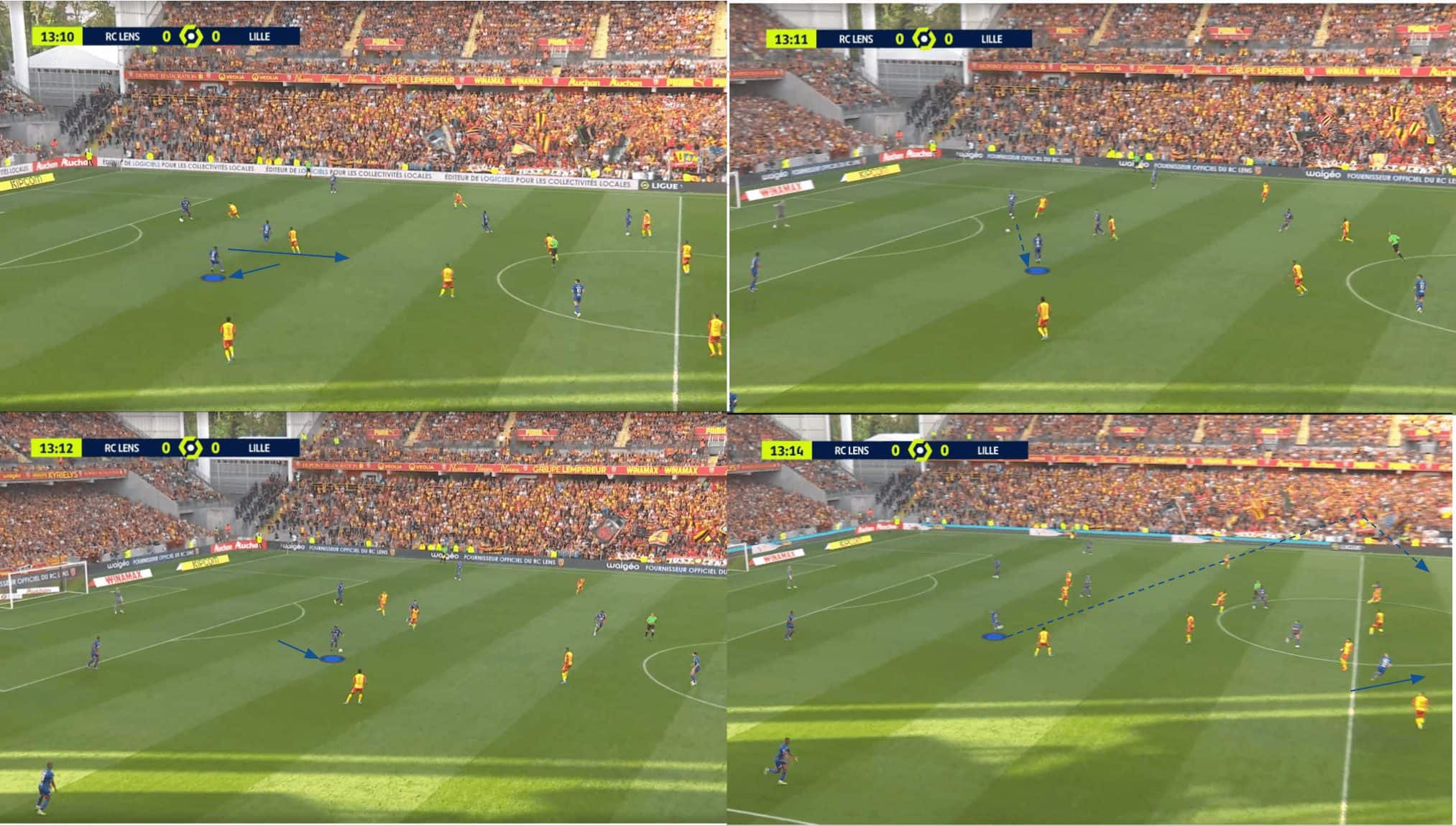
Figure 3 shows him again receiving just in front of the centre-backs, this time behind the first line of pressure as the opponent is defending more aggressively in this instance. Initially, Gomes drops off to create some space between him and the nearest opponent, making himself an attractive passing option for the left centre-back.
As he receives, he quickly turns, takes a couple of strides forward and picks out a teammate looking to exploit the space behind the opposition’s high backline. This kind of long passing over the top into space has become a staple of Gomes’ game of late. He loves performing the deep-lying playmaker role and launching balls for attackers to chase in behind.
The 23-year-old finds it quite easy to be a playmaker from deep when deployed against a high line, as he can receive and turn quickly as we saw here before getting his head up and picking out a target ahead with his impressive passing range.
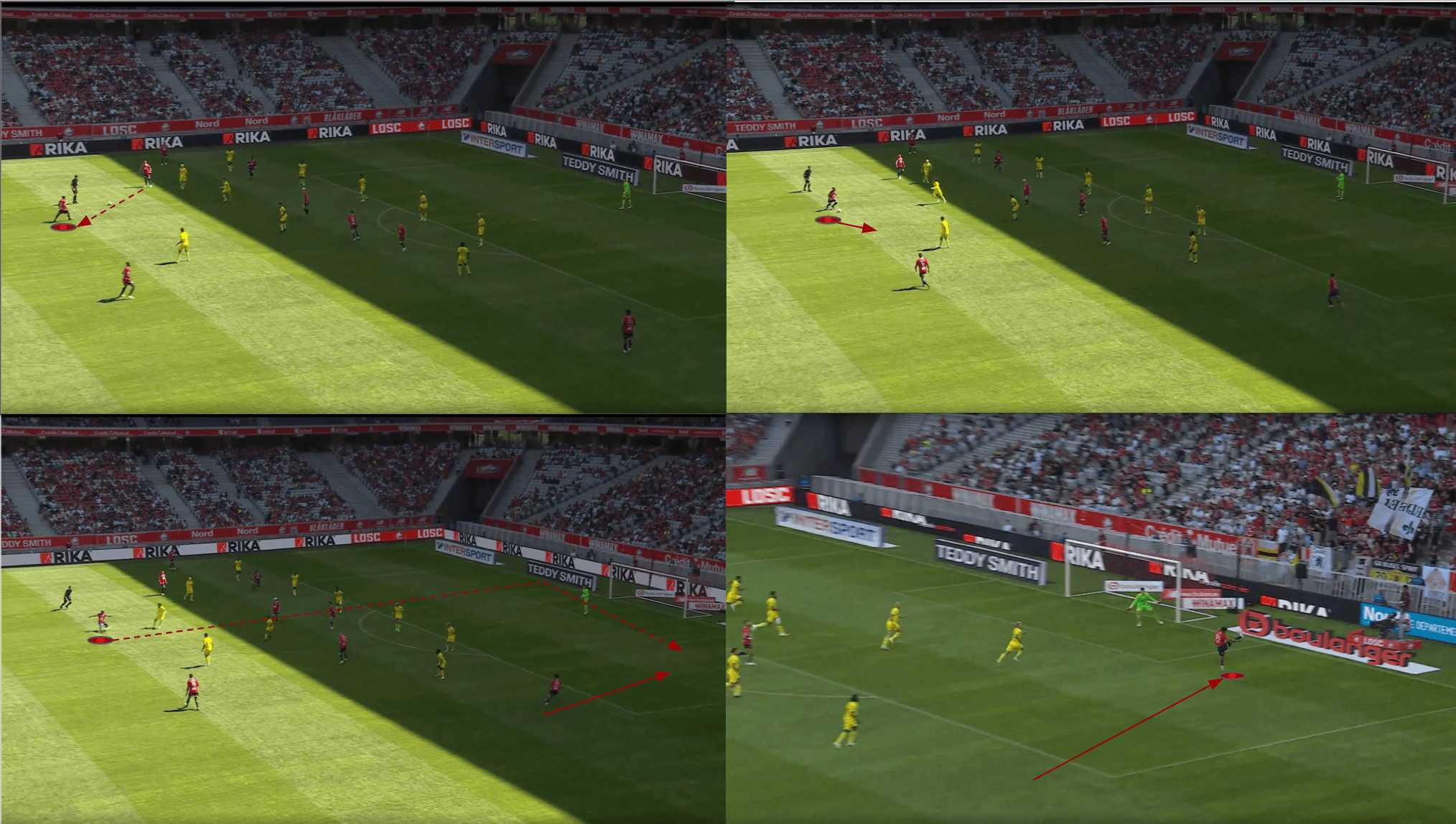
Of course, it’s not only against high lines he can be effective from a playmaking standpoint, we’ve also seen Gomes occupy deep positions in the chance creation phase, with his team camped inside the opposition’s half, this season.
In figure 4, we see the creator receiving, turning and springing a cross with a lot of backspin towards the far post for his teammate attacking that area to meet.
Again, we see him targeting space over the opposition’s defence, which is typical of how Gomes mostly likes to create chances. He’s got great passing accuracy over distance and makes difficult balls appear much easier than they are to pull off. This is massively helped by his ability to find space before receiving and keep that space thanks to the press-resistance and mentality to not dwell on the ball for too long, keeping it moving while seeking the best option.
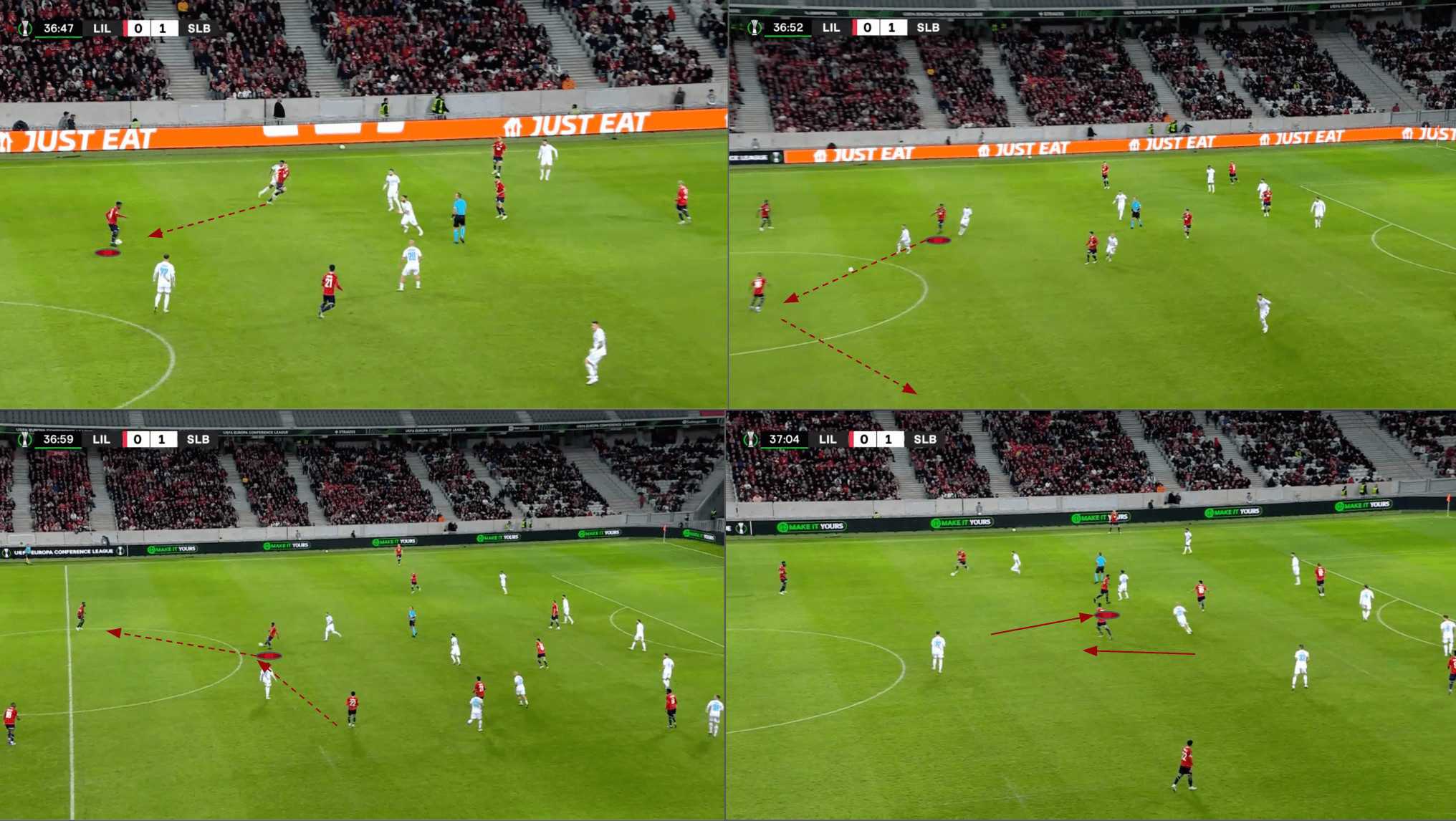
When it comes to Gomes’ game, it’s important to note he isn’t confined to deeper zones, even though he primarily likes to operate within them. For instance, here, after being positioned deep and acting as the hub of his team’s possession game through which everything flowed, he decided to advance into the final third.
The 23-year-old midfielder is afforded a lot of freedom within Paulo Fonseca’s Lille system, so it’s not uncommon to see him roaming a little bit if he believes he can offer more elsewhere. The important thing is that he ensures someone rotates into his deeper position as he advances so Lille are not left without a body in the very centre of things. We see this process in action in the bottom-right image above.
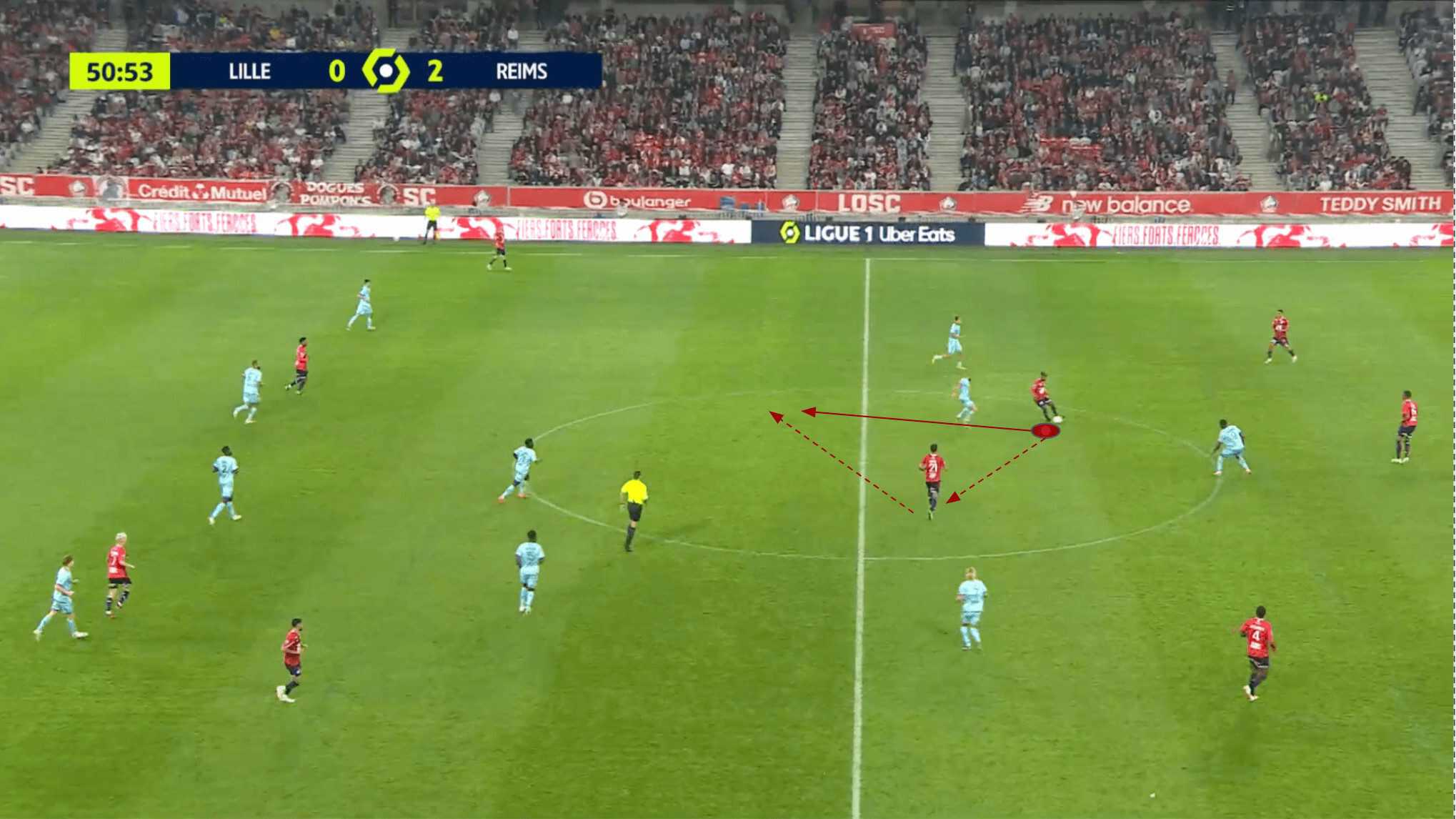
Similarly, he’ll sometimes look to get onto the receiving end of one-twos if he feels there’s no better passing option for the receiver of his initial ball than if he just advanced to become the next receiver himself.
Figures 6-7 provide an example of this; firstly, we see figure 6, where Gomes releases the first pass to Benjamin André alongside him.
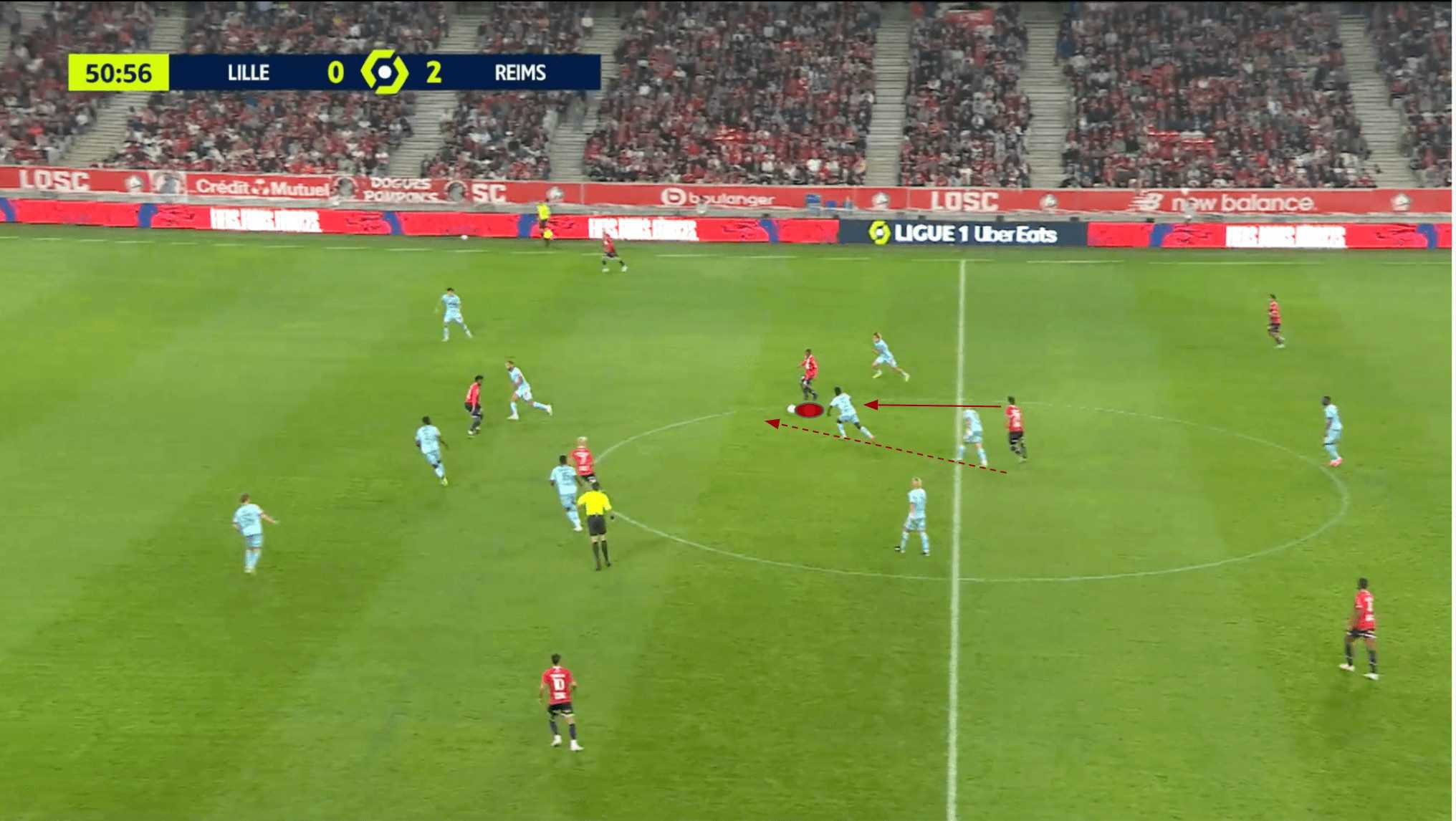
André returns the ball to Gomes as the 23-year-old makes his run beyond the opposition’s midfield line, receiving with space ahead of him to carry forward and attack the backline.
Gomes is a unique midfielder in that he’s extremely comfortable operating in deeper areas, getting heavily involved in the build-up, but due to him having spent so much time operating more as an advanced midfielder earlier in his career, those skills like dribbling and the ability to make penetrating carries are also honed and natural for him to want to express.
Essentially, he’s been the one through whom the majority of Lille’s play has flowed this term. At times, teammates of his are required to make sacrifices in terms of their own positioning to react to Gomes if he advances like we saw in the last couple of examples here, but this is necessary discipline when it comes to central midfield partnerships.
Thanks to this discipline both from himself and his teammates, Gomes has been able to express himself freely while operating in a crucial part of the pitch for Les Dogues. This is ultimately to the betterment of the team’s overall play; with Gomes playing this central role within their tactics, they currently sit fourth, just three points off third-placed PSG — not a bad start to the campaign.
Pedro Chirivella, 26 years old, Nantes
Next up is Pedro Chirivella (178cm/5’10”, 66kg/145lbs) of Ligue 1’s seventh-placed side at the time of writing, Nantes. This 26-year-old Spaniard is his club captain, demonstrating that his central role for Les Canaris extends beyond the pitch and into the dressing room as well. Addressing just what we see on the pitch, however, it’s undeniable that like Gomes for Lille, Chirivella is vital to his team’s possession play.
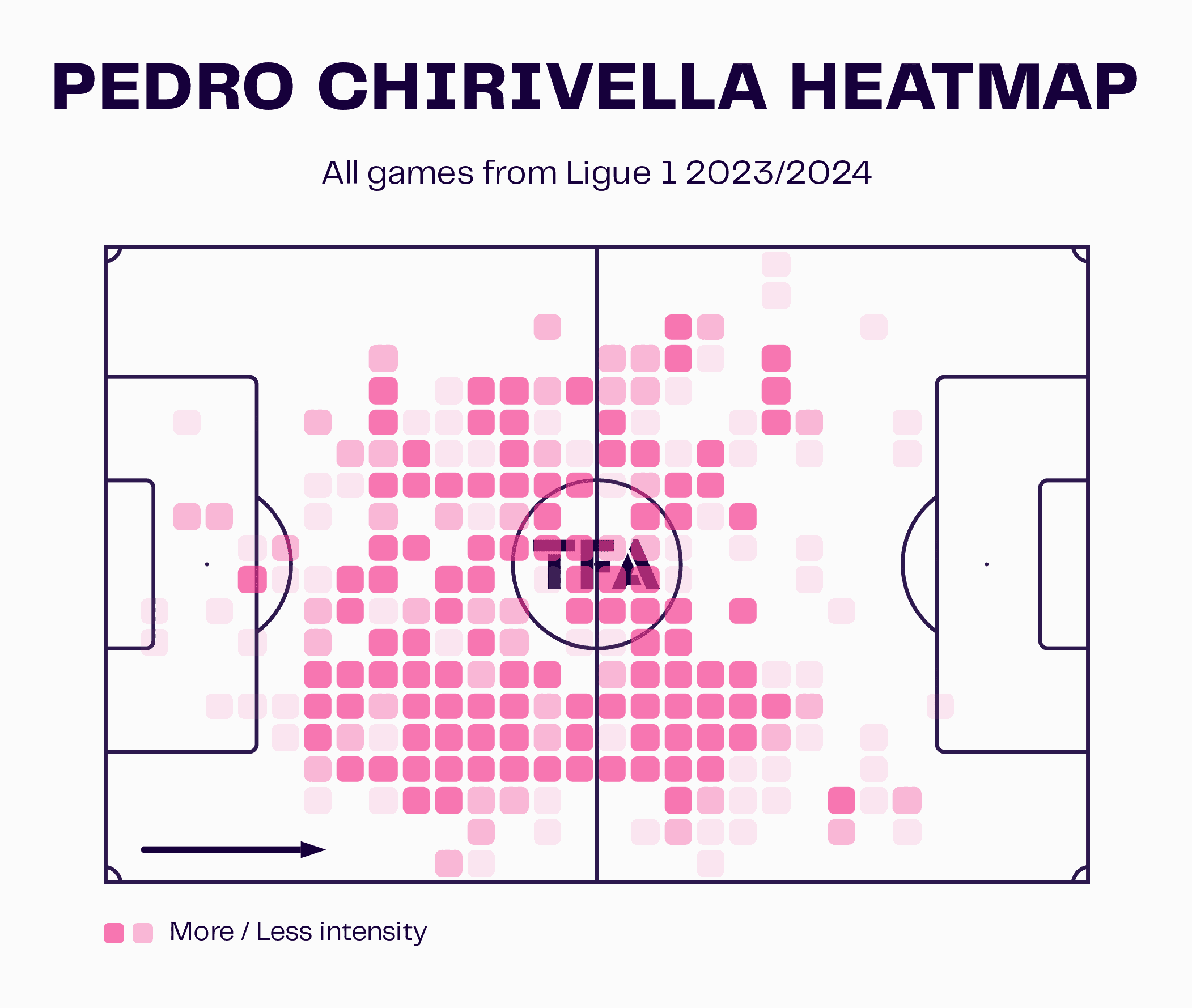
Chirivella also occupies the area just in front of the opposition’s centre-backs quite heavily. However, he tends to get a bit wider than Gomes who typically remains more central. Nantes tend to play a 4-4-2 and Chirivella will occupy the right central midfield position within that shape. However, that’s not to say he exclusively sticks to the right side of the pitch — it’s common to see him shift across to the left or, indeed, into the centre at times.
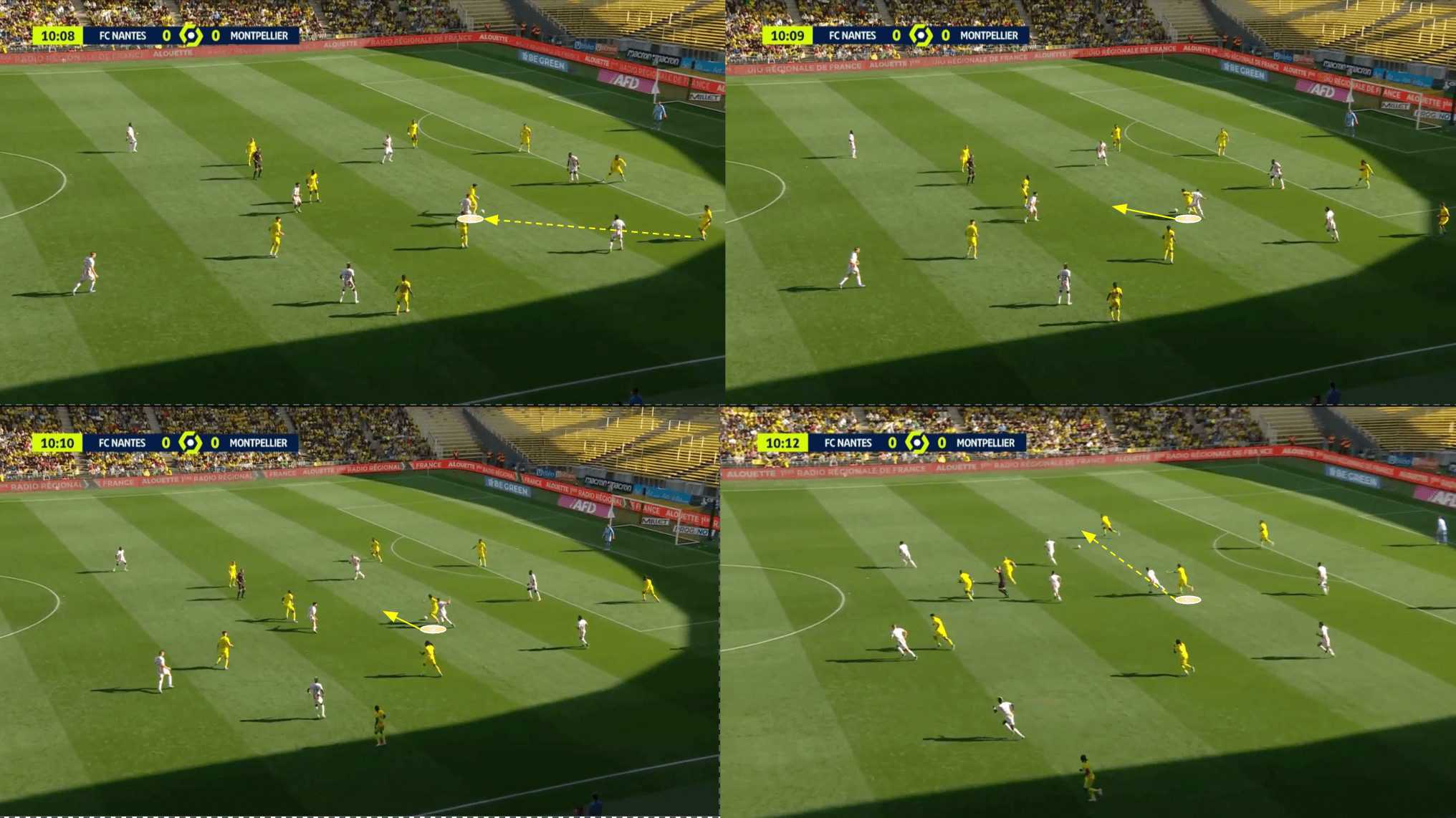
In figure 9, for instance, we see Nantes are pretty concentrated on the left side of the pitch, meaning even the right central midfielder is on this side, with the right-winger and right-back occupying more central positions just outside him.
As Chirivella receives here, we see a key difference between him and Gomes. While Gomes likes to receive in tonnes of space and defend the ball purely via his agility and sense of urgency, Chirivella is happy to receive with a defender on his back, guarding the ball with his body in a more physical sense.
Undoubtedly, with 10cm in height and 10kg in weight over Angel Gomes, the Nantes man is a more physical player better capable of backing into opponents and holding them off while shielding the ball.
Chirivella is capable of turning while holding opponents off much of the time, as we see above, which is helpful for his team as they seek to play past the opposition pressure and advance into a threatening position. Nantes will frequently look to play to Chirivella even if he’s under pressure thanks to his comfort and quality in such situations as the team look to build their attack.
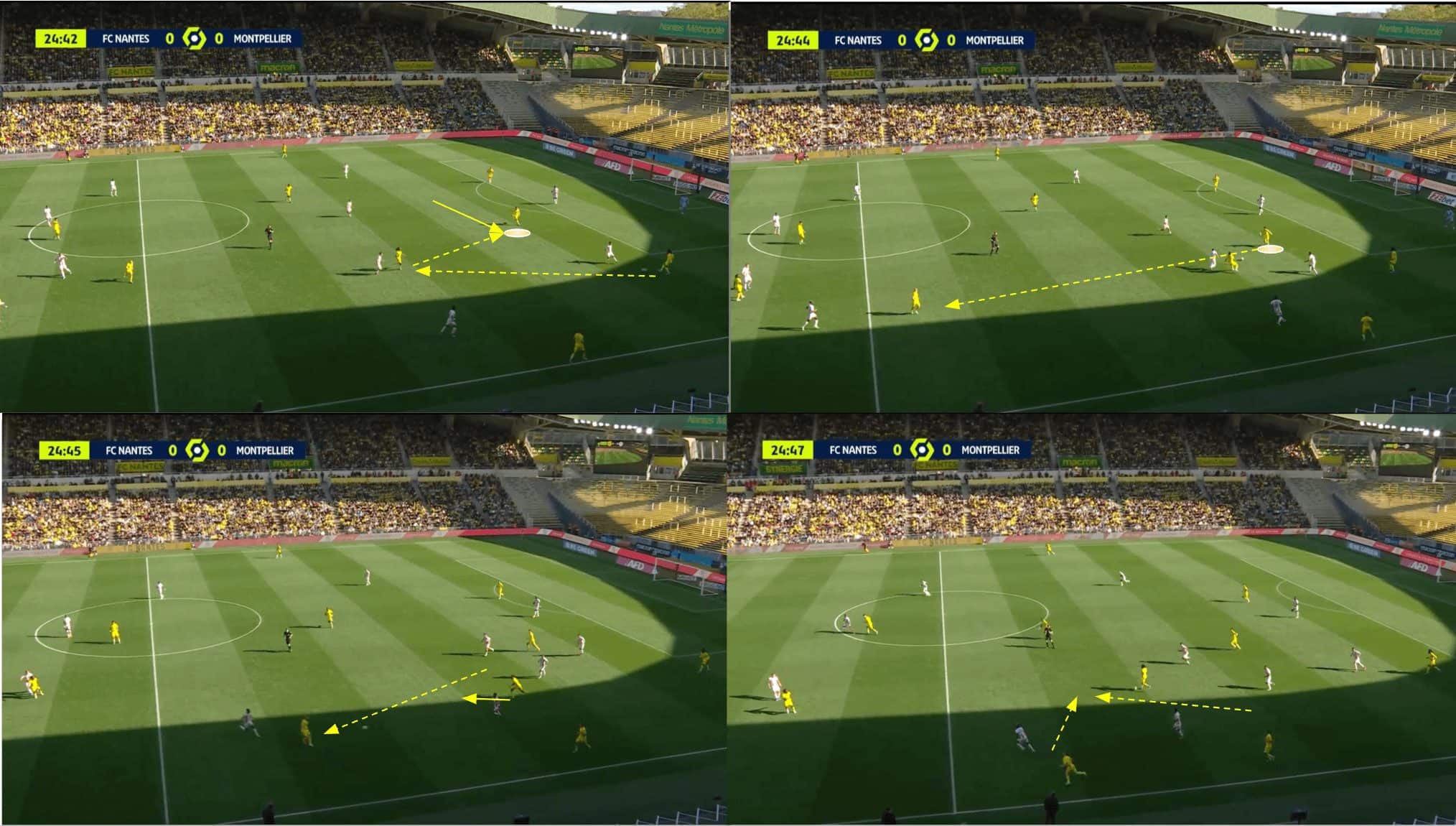
Chirivella is very active in terms of his off-the-ball movement — we commonly see him urgently move about and get relatively close to the ball carrier in his deep midfield position regardless of if they’re at the left, right or centre of the pitch, aiming to help them by creating a decent passing option.
In this case in figure 10, we see him shifting across from right to left again to help the left central midfielder receiving from the left centre-back with a defender just behind him to quickly relay the ball to him centrally on receiving.
Then, Chirivella can quickly send the ball forward to the left-winger dropping off into the half-space. In the end, this move results in Nantes beautifully playing through the opponent’s defensive shape and creating an opportunity for a player to run at the opposition’s backline.
Through his movement into a valuable position near the ball-carrier and his quick decision-making, we see an example of how Chirivella facilitates quick, one-touch passing play. The 26-year-old Spaniard loves to play quick football like this, with one-touch combinations being a common sight within his game. He likes to give teammates chances to play in this way via his positioning and certainly likes to play this way himself — and is effective when doing so.
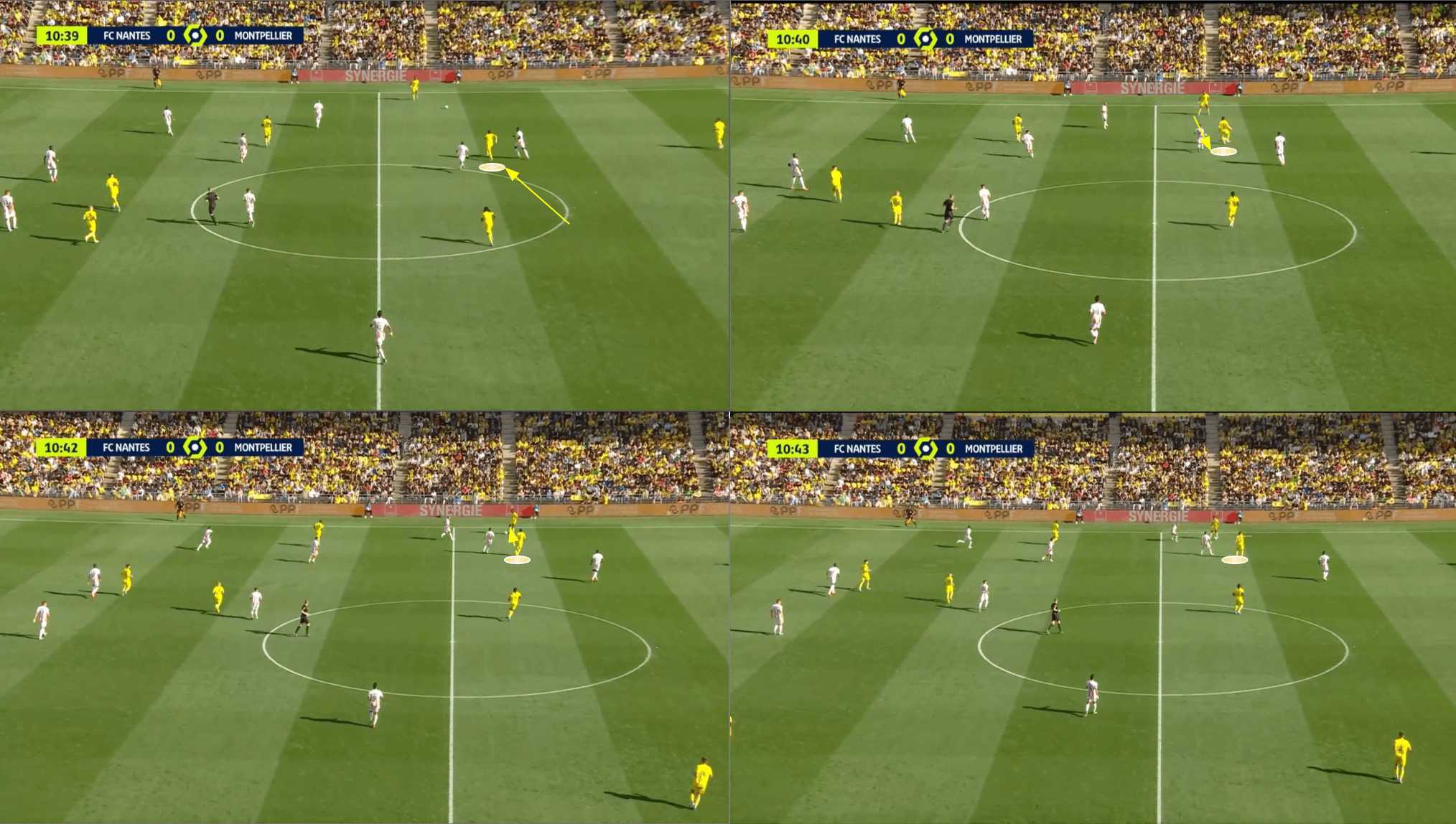
Figure 11 provides another example of how Chirivella will frequently move about to try and find the best position for himself to be a helpful passing option for his teammates as they seek progression.
Perhaps, at times, he even gets too close to teammates and a bit of space at the same angle could be valuable, but he likes to engage in quick, intricate passing plays and proximity helps him do so.
In this case, he receives and quickly sends the ball back, ignoring the potential passing option behind him due to the presence of two opponents directly behind him in the top-right image. In the end, he directs the right-back to send the ball backward, which is what happens, highlighting his role as somewhat of a general in Les Canaris’ midfield.
It’s unfortunate he was unable to receive and turn to exploit the central midfielder in space behind him on this occasion — and perhaps there were ways of doing so — but he still helped his side retain possession, escape the pressure on this wing and set themselves up to progress beyond the opponent later, which is another important aspect of his role at Nantes — being responsible in possession and not taking unnecessary risks to ensure the team isn’t left in a vulnerable transition-to-defence situation.
Chirivella certainly is just that — a responsible holding midfielder who behaves in a trustworthy manner with the ball, capable of breaking lines and playing progressively but not forcing the issue if it’s not on. His main strength probably lies in his ability to constantly provide options for teammates via his off-the-ball movement; he can improve his spatial awareness and proximation in certain cases, perhaps providing more space to the ball-carrier to facilitate even better progression.
Jordan Ferri, 31 years old, Montpellier
The third and final player we’ll provide some analysis of in this scout report is Montpellier’s Jordan Ferri (173cm/5’8”, 73kg/160lbs). An Olympique Lyon academy product, Ferri has been plying his trade with La Paillade since 2019 when he joined from Les Gones for €2m; 136 games later, that transfer fee seems a real bargain.
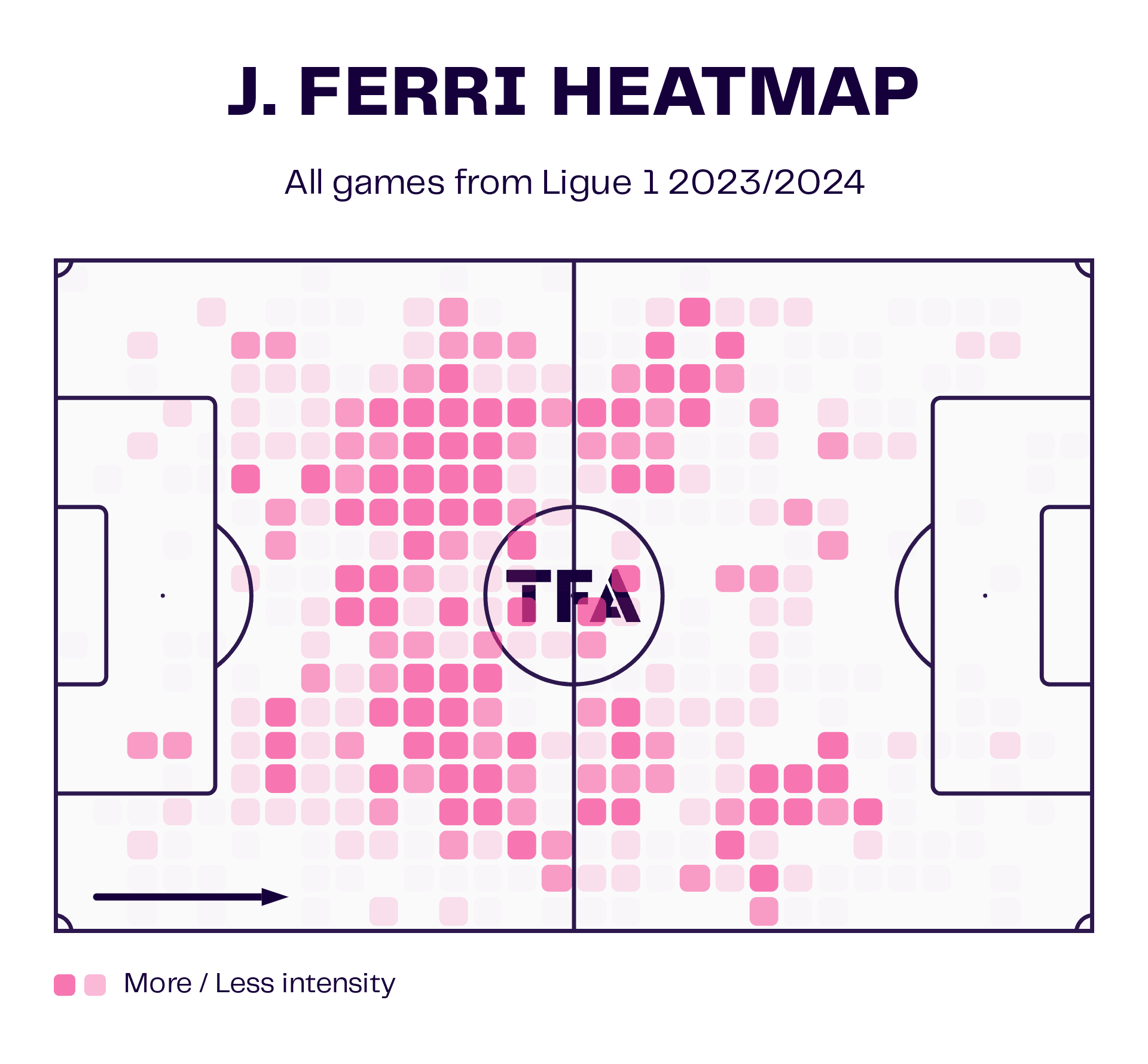
The oldest player on our list at 31 years of age, Ferri is another like Chirivella who will frequently vacate the centre of midfield for slightly wider areas when receiving from the backline. In fact, we’d say Ferri tends to get even wider than Chirivella on average when he does move out from the centre.
Furthermore, again similar to Chirivella, Ferri typically plays in a two-player midfield on the right of that pairing.

Figure 13 shares an example of where you can typically expect to find Ferri when he does drop out wide to receive from the backline. Ferri almost becomes like a right centre-back in a back-three, allowing the right-back alongside him to advance almost like a wing-back.
This movement is a crucial aspect of Montpellier’s progression phase, as the knock-on effects see the entire dynamic change further upfield. As the wing-back advances, the right-winger comes inside, creating a closer connection between them, the ‘10’ and the centre-forward which can result in some lethal combinations if found by the progressive pass from deep.
On this occasion, Ferri manages to pick out the ‘10’ with his movement across into the right half-space on the nearest opposition player’s blind side.
Ferri can show off his wide passing range from this position which enables him to make good use of his impressive vision, showcasing how these tactics enhance some of the 31-year-old midfielder’s key qualities.

It’s not just progressive passing you can expect from Ferri as he drops out into this promising position for progression either. At times, the passing options are all marked up but space is left in front of Ferri for him to carry the ball into, which is what we see happens in figure 14 above.
As he carries forward, he has to skip over one challenge in midfield which he achieves very well before he’s bearing down on the backline. His carry drags the opposition’s left-back out which frees up space ahead of the winger which can be targeted.
In the end, we see Ferri slip the ball just beyond the charging left-back, into the right-winger’s path — a perfectly weighted and accurate through pass that highlights the 31-year-old’s playmaking ability. However, it’s his initial carry that created the opportunity, and that is undoubtedly another big positive to his game.
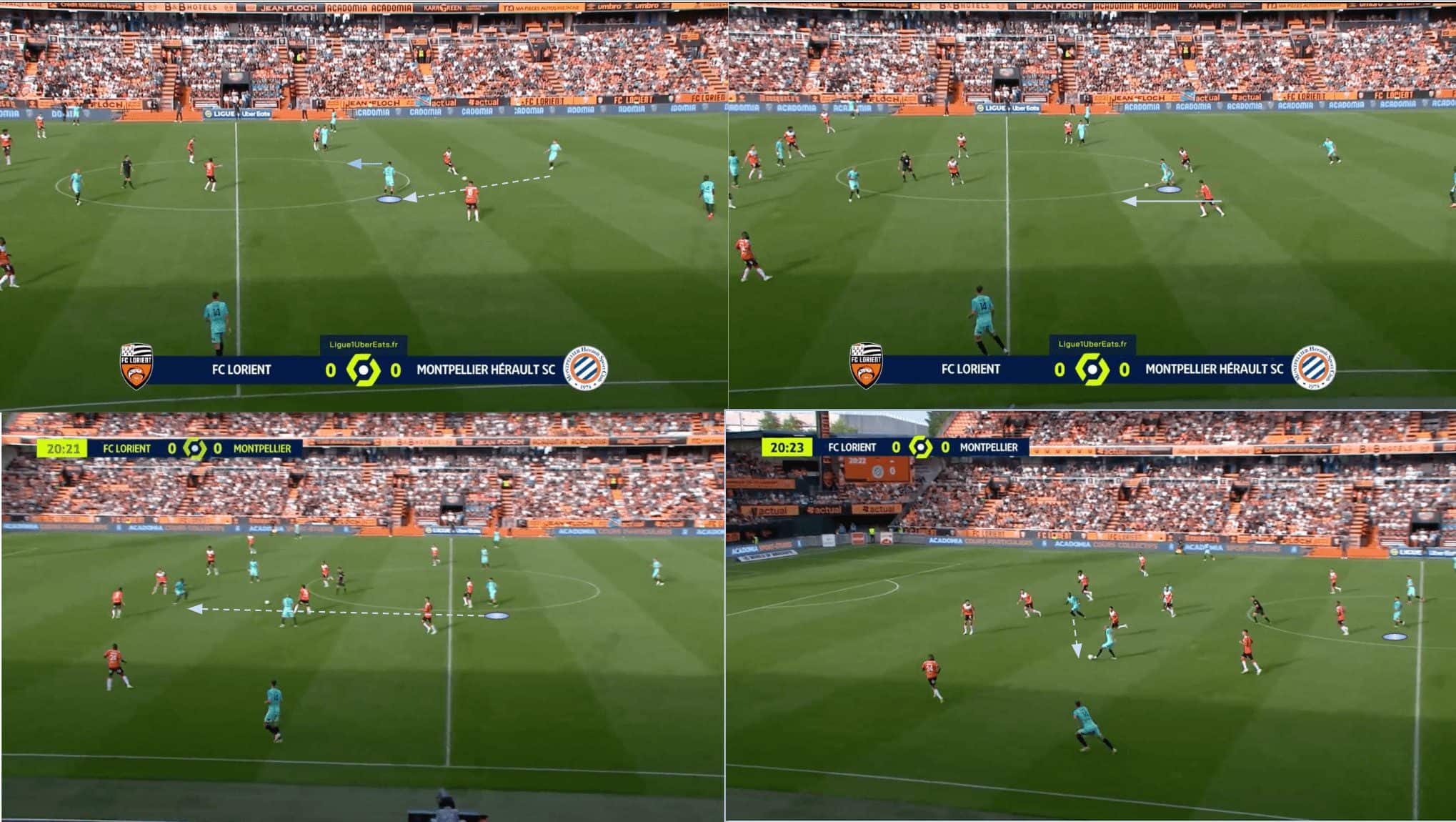
Of course, it’s not just out wide we see Ferri receive possession, he does get involved centrally plenty of the time as well. Here in figure 15, we see him receiving with space behind him to turn into.
Having scanned prior to receiving and got his head up again after the pass was played, Ferri spotted a slight gap in the opposition’s midfield line which he could exploit via a drilled pass along the ground into the centre-forward’s feet which progressed his team right to the edge of the final third.
From here, the centre-forward exhibits some effective hold-up play, combines with a nearby midfielder advancing forward on his left and sets Montpellier up to hurt Lorient as they’re now facing the goal just on the edge of the final third.
This risky progressive pass from Ferri paid off big time on this occasion and set his team up nicely to quickly advance into a very threatening position. The pass could’ve backfired, of course, and Montpellier would’ve been quite exposed in transition but Ferri is a risk-taker at times who’s happy to take a chance in order to advance his side into a better position even if the odds are a little lower than would be ideal.
Like Gomes and Chirivella, Ferri is central to his side’s possession play and his effectiveness in that role this term thanks to his movement, technical quality and bravery deserves recognition despite La Paillade’s overall struggles.
Conclusion
To conclude this tactical analysis and scout report, while all three of these vital ball distributors have some similarities in that they all tend to primarily play just in front of the backline in the build-up and progression phases, they all have unique roles that are fine-tuned to suit their respective teams and the ways in which they look to play.
The overall goal for all is similar, they receive from the backline and facilitate progression to more dangerous areas. Our tactical analysis has highlighted how all three differ slightly in terms of how they achieve this by the ways in which their teams look to enhance their unique strengths and minimise their weaknesses.

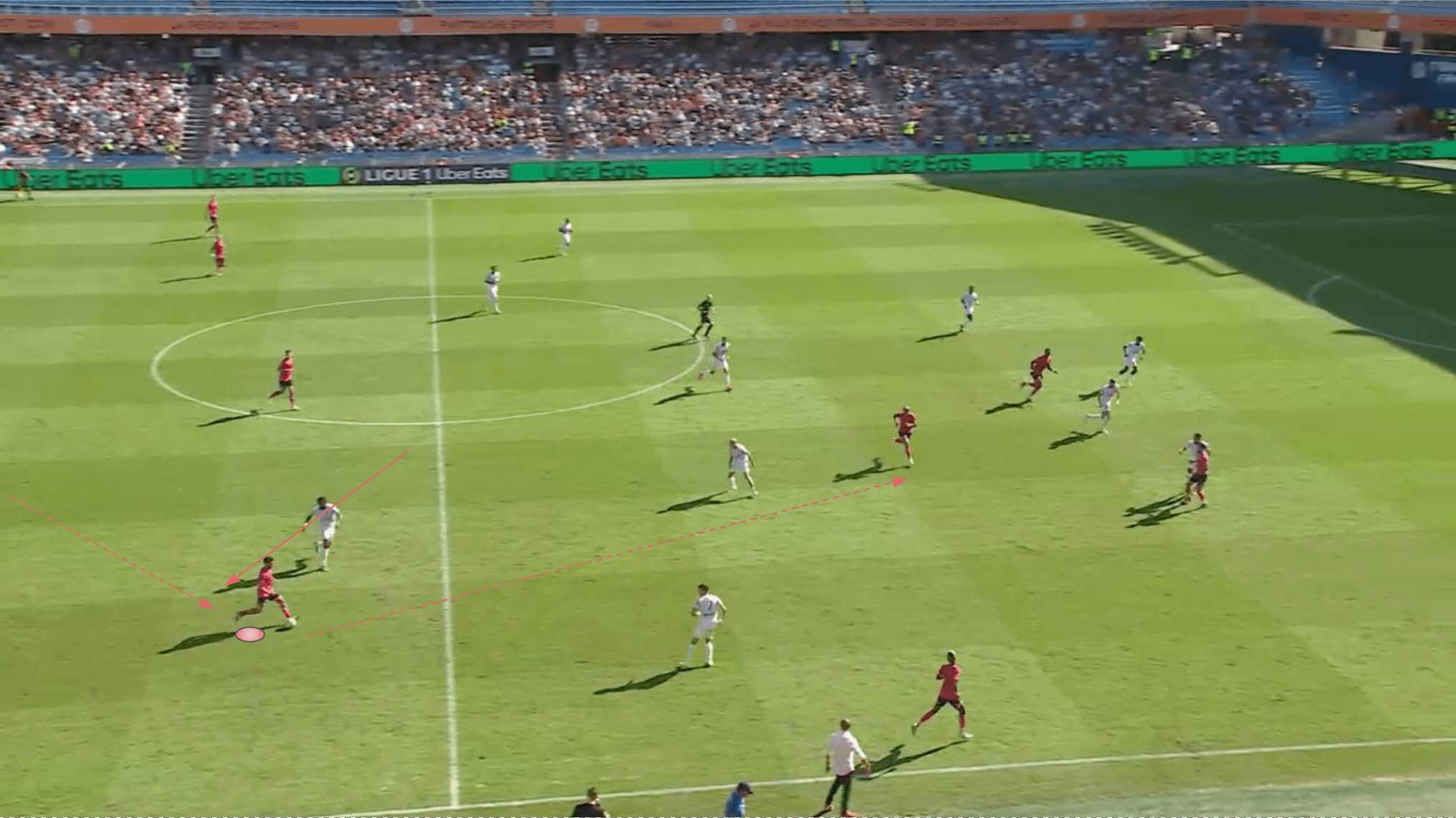



Comments